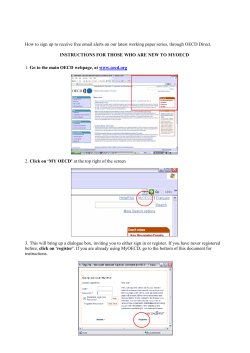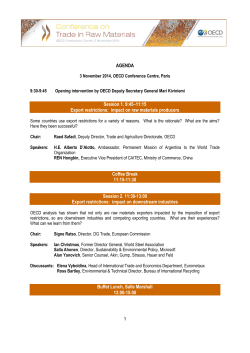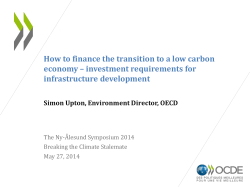
Press Release - Center on International Cooperation
Embargoed for Release: March 26, 2015, 1 p.m. EDT Contact: James Devitt 212.998.6808 james.devitt@nyu.edu RICH COUNTRIES ARE FAILING THE MOST VULNERABLE, SAYS NEW REPORT BY OECD Donor countries are sending more than half of their aid to countries marked by conflict, but they are not keeping their promises to promote peace and build state institutions, according to a new report authored by New York University’s Center on International Cooperation for the Organization for Economic Co-operation and Development (OECD). “If we are not addressing fragility, we may be leaving behind some of the most vulnerable members of the international community,” says Jom Lomøy, Director of the OECD’s Development Cooperation Directorate. “The goal of eradicating poverty will remain beyond the reach of many countries unless concentrated efforts begin now to address fragility,” write the Center on International Cooperation researchers. “If institution building and conflict reduction continue at their existing pace, by 2030 nearly half a billion people could remain below the poverty line of $1.25 a day.” The report, “States of Fragility 2015: Meeting Post-2015 Ambitions,” considers several variables in making evaluations of the risks that “fragility” poses to development: 1) levels of violence from conflict and crime; 2) access to fair justice systems for all people; 3) accountability, effectiveness, and inclusiveness of government institutions; 4) economic stability, growth and job creation; and 5) capacity to prevent and adapt to economic and environmental shocks and disasters. It also examines how likely such states are to achieve the UN Open Working Group’s post-2015 sustainable development goals and targets in these areas. The report comes ahead of governments’ formal consideration of a successor to the Millennium Development Goals, which were established in 2000 and aimed at reducing severe poverty through advances in education and health. The report’s authors acknowledge that many fragile states and economies have made important strides toward reaching these goals; however, as a group, they have lagged behind other developing countries. “Nearly two-thirds of those now considered fragile are expected to fail to meet the goal of halving poverty by 2015,” they write. “Just one-fifth will halve infant mortality by 2015, and just over one-quarter will halve the number of people who do not have access to clean water. —more— Rich Countries are Failing the Most Vulnerable, Says New Report by OECD/p. 2 “These trends point to a growing concentration of absolute poverty in fragile situations—today, the 50 fragile countries and economies monitored by the OECD are home to 43 percent of people living on less than $1.25 a day; by 2030, the concentration could be 62 percent.” The report notes that development assistance to fragile situations has nearly doubled over the past 15 years. However, this aid has been distributed unevenly. Afghanistan and Iraq received significant flows during this period—22 percent of all official development assistance (ODA) sent to fragile states and economies. The authors add that the largest aggregate financial flow to fragile states and economies is remittances – money that migrants send home to their families – but they benefit a small number of middle-income countries with big diaspora populations, such as Nigeria and Egypt. Without international will to expand migration, the report’s authors predict, poorer regions will benefit less from remittances. In addition, only 6 percent of foreign direct investment to developing countries in 2012 went to fragile situations, and these resources were concentrated in just 10 resource-rich countries with large natural resource deposits, including Nigeria, Iraq, the Democratic Republic of Congo, and Egypt. Many countries will remain dependent on aid unless more efforts are driven into accelerating national capacities for domestic revenue generation and attracting the international private sector, the researchers conclude. They also note low levels of aid dedicated to building security and justice institutions—less than 4 percent of all aid—and the low levels of funds directed to building health institutions prior to the recent Ebola outbreak. For instance, in 2012, a total of $9 million was spent on building infectious disease control health systems in Guinea, Liberia, and Sierra Leone; in 2014, the United Nations made an emergency appeal for over $1 billion to control the spread of the disease in these three countries. A complete copy of the report may be downloaded here: www.oecd.org/dac/governance-peace. The OECD’s “States of Fragility 2015” was authored by Sarah Hearn, associate director and senior fellow at CIC, and co-authored by CIC senior fellows Ben Oppenheim and David Steven. Editor’s Note: The Organisation for Economic Co-operation and Development (OECD) is a global economic policy forum. It provides analysis and advice to its 34 member governments and other countries worldwide, promoting better policies for better lives. For more, please visit www.oecd.org. The Center on International Cooperation (CIC) creates the ideas, analysis and policies needed to transform international cooperation on leading global challenges, such as increasing peace and security, strengthening fragile states, securing strategic resources and tackling climate change. For more, please visit cic.nyu.edu. ###
© Copyright 2025





















